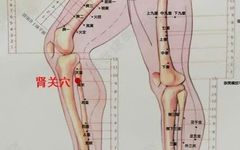01
All Courses by Ni Haixia
02
Complete Guide to TCM Treatments for Common Ailments
03
Focused Study on TCM Topics
04
Online Reading of TCM Learning Books
Ten Effective Acupuncture Techniques for Immediate Relief!
1. Heavy Child Point for Chronic Back Pain, Immediate Effect, No Other Point in the Fourteen Meridians Can Compare
Location: One inch below the tiger’s mouth on the palm, between the metacarpal bones of the thumb and index finger, connected to the Daba (大白) point on the back of the hand. Anatomy: Contains the radial nerve, radial artery, and branches of the lung nerve. Point Selection: With the palm facing up, the point is located one inch below the space between the metacarpal bones of the thumb and index finger, which can connect to the Daba point. Meridian: Enters the Lung Meridian. Point Function: Dispels wind and releases the exterior, clears lung qi. Indications: Pneumonia, lung cancer, emphysema, colds, cough, asthma, palpitations, fever reduction, laryngitis, back pain, chest pain, knee pain. Needling Method: Insert straight for one to two inches. For pediatric conditions, using a three-edged needle to draw blood is particularly effective. Sensation: Aching and distending pain sensation. Explanation: The Heavy Child and Heavy Immortal points are close to the traditional fourteen meridian Lung Meridian, thus they can treat lung-related diseases like the Yiji (鱼际) point.
2. Kidney Gate Point for Frequent Urination
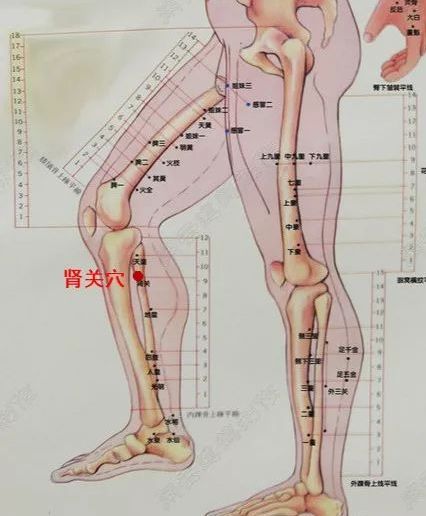
Location: The Kidney Gate point is located one and a half inches below the Tianhuang (天皇) point.
Indications: Excess stomach acid, regurgitation, strabismus, astigmatism, anemia, epilepsy, neurological disorders, brow pain, nasal bone pain, dizziness.
Needling Method and Application: Insert five to one inch. Supplement the kidney by inserting two inches deep. Treat excess stomach acid and regurgitation with the Tianhuang point as a paired point.
3. Wood Point for Goose Foot Disease
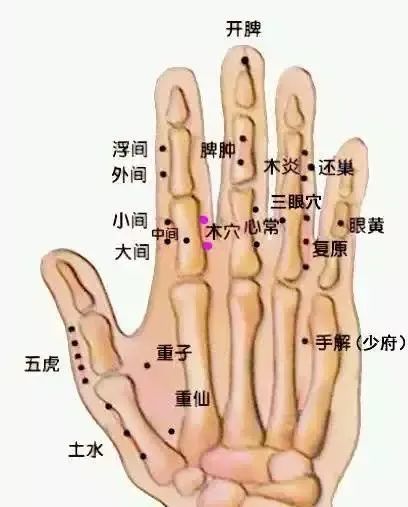
Wood Two Point
Location: Three-tenths of an inch from the center of the first phalanx of the index finger on the palm side.
Anatomy: Contains the intrinsic palmar digital nerve and liver nerve.
Point Selection: With the palm facing up, the point is located three-tenths of an inch from the center of the first phalanx of the index finger.
Meridian: Enters the Liver Meridian.
Point Function: Soothes the liver, regulates qi, invigorates blood, and dispels wind.
Indications: Irritability, excessive activity, shoulder tightness and pain, right flank pain, neck stiffness, high cholesterol, stomach distension and pain.
Needling Method: Use a five-tenths needle, insert straight for two to four tenths.
Sensation: Localized aching and distending pain sensation.
Application: Using both hands for point selection yields better results.
Explanation:
(1) In the works of Dong Gong, the Wood Point has a limited range of indications, while Master Hu expanded its range. Lai Zhu in his book referred to the Wood Point as the cold point, stating that it is effective for tearing, sweating, stopping sweating, and colds. He claimed that the Wood Point can stop cold-induced runny nose in a moment. However, the author believes that for treating cold-induced runny nose, it is better to pair the Wood Point with the Sancha (三叉) point, Linggu (灵骨), Daba (大白), and add the foot cold point for better results.
(2) The Wood Point corresponds to the liver area in the holographic projection of the body’s organs, hence it is called the Wood Point. Therefore, selecting this point is particularly effective for treating right flank pain.
Wood One Point
Location: Two and a half tenths of an inch below the Wood Two Point on the palm side of the index finger.
Anatomy: Contains the intrinsic palmar digital nerve and liver nerve.
Point Selection: With the palm facing up, the point is located two and a half tenths of an inch below the Wood Two Point.
Meridian: Enters the Liver, Stomach, and Lung Meridians.
Point Function: Clears liver and gallbladder heat, opens obstructions.
Indications: Bitter mouth, tinnitus, excessive liver fire, irritability, shoulder pain, right flank pain, neck tightness, high cholesterol, stomach distension and pain.
Needling Method: Use a five-tenths needle, insert straight for two to four tenths.
Sensation: Localized aching and distending pain sensation.
Application: Same as Wood One Point.
Explanation:
(1) The depth of the needle affects the meridian it enters. The Wood One, Wood Two, and Wood Three points are listed by Master Hu. In Dong Gong’s book, there are two illustrations of the Wood Points, but only one Wood Point is mentioned in the text. These three points can be used with a five-tenths needle, shallowly inserted one-tenth into the Lung Meridian, and deeply inserted two to four tenths into the Liver and Stomach Meridians. This is also a unique feature of Dong’s extraordinary points, where the depth of insertion determines the meridian it belongs to, which should be noted.
(2) There are three Wood Points, and using all three needles together in a reverse horse needle technique for right flank pain is very effective. It is also effective for dry mouth and excessive heat.
Wood Three Point
Location: Two and a half tenths of an inch above the Wood Two Point on the palm side of the index finger.
Anatomy: Contains the intrinsic palmar digital nerve and liver nerve.
Point Selection: With the palm facing up, the point is located two and a half tenths of an inch above the Wood Two Point.
Meridian: Enters the Liver, Stomach, and Lung Meridians.
Point Function: Clears liver and gallbladder heat, opens obstructions.
Indications: Bitter mouth, tinnitus, excessive liver fire, irritability, shoulder pain, right flank pain, neck tightness, high cholesterol, rib pain, stomach distension and pain.
Needling Method: Use a five-tenths needle, insert straight for two to four tenths.
Sensation: Localized aching and distending pain sensation.
Application: The Wood One, Wood Two, and Wood Three points can be used clinically, and any one or two points can be selected for treatment. Using a three-edged needle to draw blood is very effective for treating gastrointestinal distension and flank pain. Using both hands for point selection is not contraindicated.
Explanation: In Lai Zhu’s experience with the Wood Points, the Wood Points can treat easy tearing and dryness of the eyes. Additionally, the Wood Points can stop external wind pathogens from causing skin itching, as this point enters the Liver Meridian, which connects to the eyes. Therefore, as Lai Zhu stated, it can treat the above symptoms. The author believes that if the Wood Points are paired with Dong’s extraordinary points, such as the Upper Three Huang (上三黄) point, the effect will be even better.
4. Gynecological Points for Infertility
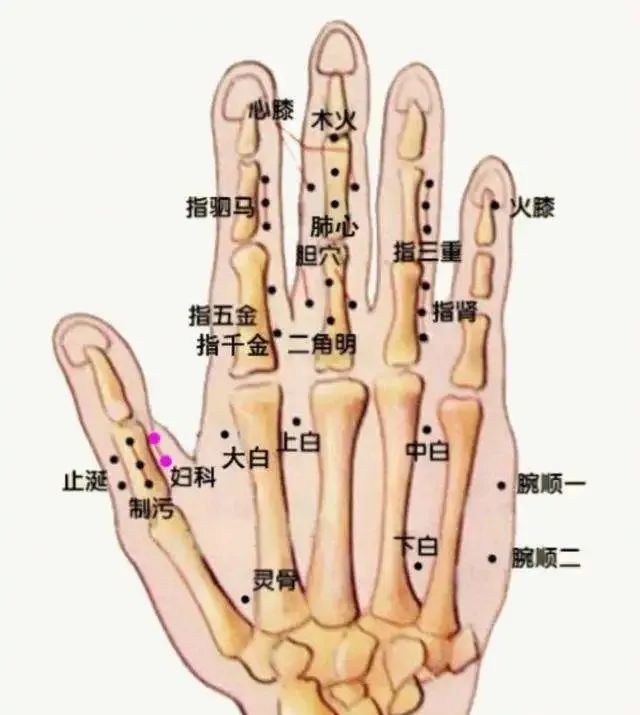
Gynecological Five Points
Location: On the back of the hand, the outer side of the first phalanx of the thumb, starting from the transverse crease of the palm, each point is spaced two tenths apart, totaling five points.
Anatomy: Contains the intrinsic palmar digital nerve superficial branches, uterine nerve, and six fu organ nerves.
Point Selection: On the back of the hand, at the outer side of the first phalanx of the thumb, two and a half tenths from the center, each point spaced two tenths apart, up to the second phalanx transverse crease, totaling five points.
Meridian: Enters the Ren and Du Meridians.
Point Function: Regulates the Ren and Du vessels, facilitates the lower jiao.
Indications: Uterine tumors, uterine cancer, uterine inflammation, ovarian inflammation, infertility, menstrual pain, irregular menstruation, excessive or insufficient menstruation, vaginal pain and swelling, red or white discharge, postpartum wind syndrome (postpartum wind syndrome).
Needling Method: Use a five-tenths needle, insert straight for two to three tenths, or use a three-edged needle for shallow bloodletting.
Sensation: Localized aching and distending pain sensation.
Application: The Gynecological Five Points are special points for various women’s diseases. Clinically, any two to three points can be selected for needling, yielding immediate effects.
Explanation:
(1) The Gynecological Five Points are the main points for treating various gynecological diseases and are essential points for gynecological treatment. They can be combined with other points such as Fengchao (凤巢), Mufu (木妇), etc. The pairing of this point with the Menjin (门金) point is particularly effective for menstrual pain.
(2) In Dong Gong’s book, there are two points, while Master Hu added three points, totaling five points. The author believes that three points can be selected in this area for the reverse horse technique.
5. Sima Point for Allergic Rhinitis and Various Skin Diseases
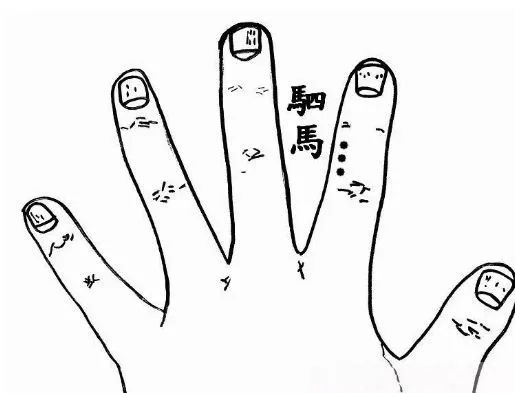
Sima Two Point
Location: Sima Two Point is located on the back of the hand, three tenths from the center of the second phalanx of the index finger.
Sima One Point is located two and a half tenths below Sima Two Point.
Sima Three Point is located two and a half tenths above Sima Two Point.
Anatomy: Contains the superficial branches of the median nerve, branches of the lung nerve.
Point Selection: Same as the above points.
Meridian: Enters the Lung Meridian.
Point Function: Dispels wind, releases the exterior, harmonizes qi and blood.
Indications: Skin diseases, facial blemishes, freckles, rhinitis, tinnitus, otitis media, chest pain, pleurisy.
Needling Method: Insert straight for one to two tenths.
Sensation: Localized aching and distending pain sensation.
Explanation: The Sima Point is on the same line as the Wujin (五金) and Qianjin (千金) points. The Wujin point is on the first phalanx of the index finger, while the Sima point is on the second phalanx. Dong Gong originally indicated two tenths, while Hu indicated three tenths, which accounts for the difference.
Experience: The Sima Point has both hand and foot Sima points, both of which enter the Lung Meridian and are primary points for regulating qi, mainly treating skin-related issues. They are effective for various skin diseases, acne, and blemishes.
Pairing Points:
(1) For treating blemishes, pair the Sima Point with the Upper Three Huang (上三黄) point for better results.
(2) For treating swollen and inflamed acne, this point can be paired with the San重 (三重) point.
Needle and Upper Three Huang for various bone spurs.
6. Tongguan, Tongshan, and Tongtian Combined with Bloodletting Needle Method for Treating Viral Myocarditis

Tongguan Point: Located on the midline of the thigh, five inches above the knee crease.
Tongshan Point: Located two inches above the Tongguan Point on the midline of the thigh.
Tongtian Point: Located four inches above the Tongguan Point on the midline of the thigh.
Indications: Heart disease, pericarditis (chest pain), pain on both sides of the heart, rheumatic diseases originating from the heart, dizziness, blurred vision, palpitations, stomach diseases, limb pain, cerebral anemia.
Needling Method and Application: Insert deep for five tenths to one inch and five tenths. Tongguan, Tongtian, and Tongshan points are generally selected one to two points for needling. For hypertension, only one point should be selected on each foot.
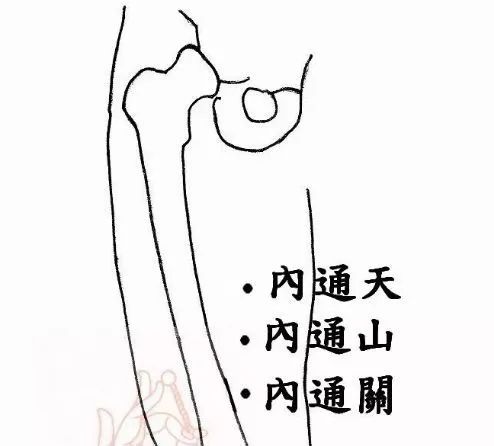
Internal Tongguan Point: Open five tenths inward from the Tongguan Point.
Internal Tongshan Point: Open five tenths inward from the Tongshan Point.
Internal Tongtian Point: Open five tenths inward from the Tongtian Point.
Indications: Hemiplegia, limb weakness, limb nerve paralysis, heart failure, stroke with speech impairment, back pain and weakness caused by heart dysfunction, limb weakness.
Needling Method and Application: Insert deep for five tenths to one inch. Use Internal Tongguan, Internal Tongshan, and Internal Tongtian together, forming a straight three-needle reverse horse technique.
7. Lower Three Huang for Diabetes
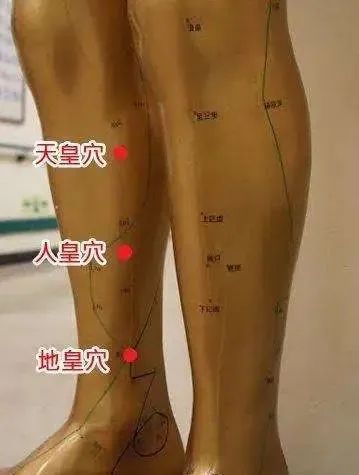
Tianhuang Point
Point Location: Bend the knee, one inch below the inner condyle of the tibia. This is one inch below the Yinlingquan (阴陵泉) point of the fourteen meridians.
Meridian Anatomy: Contains the nerve of the kidney, six fu organ nerves, and branches of the heart nerve.
Point Selection: Located one inch below the inner edge of the tibia at the knee. This is one inch below the Yinlingquan point of the fourteen meridians.
Meridian: Enters the Heart and Kidney Meridians.
Indications: Excess stomach acid, regurgitation (reflux), kidney inflammation, diabetes, protein in urine, cystitis.
Needling Method: Insert straight for five tenths to one inch and five tenths.
Sensation: Aching, distending, and electric sensation.
Note: Pregnant women should not be needled. Moxibustion is also not recommended.
Identification: The correct location of the Tianhuang Point is one inch below the Yinlingquan point of the fourteen meridians, not the Yinlingquan point itself. Do not confuse them to avoid affecting the results, as the indications for Yinlingquan and Tianhuang differ. Readers should compare them themselves.
Application: This point can be paired with the Tianhuang auxiliary point to treat regurgitation and excess stomach acid.
Experience: This point has reaction points on both sides of the neck near the supraclavicular fossa. Using pressure techniques can relieve pain in the neck area.
Pairing Points:
(1) For neck sprain pain, this point can be paired with the Wanshun San (腕顺三穴) point (near the Houxi (后溪) point), combined with guiding qi needle techniques, generally yielding immediate results. If the effect is not apparent, bloodletting can be performed at the pain point.
(2) For shoulder pain, this point or the Kidney Gate point can be paired with the Shoulder Congestion Point (肩凝穴) (located between the Sanjian (三间) and the middle of the Sanjian), and if bloodletting is performed at the pain point, the effect is particularly effective.
Renhuang Point
Point Location: Located three and a half inches above the inner ankle bone. This is five tenths above the San Yin Jiao (三阴交) point of the fourteen meridians.
Anatomy: Contains the nerve of the kidney, branches of the lung nerve.
Point Selection: Located three and a half inches above the inner ankle bone, this is five tenths above the San Yin Jiao point of the fourteen meridians.
Meridian: Enters the Lung and Kidney Meridians.
Point Function: Harmonizes blood, relaxes tendons, supplements kidney essence.
Indications: Gonorrhea, impotence, premature ejaculation, nocturnal emissions, lumbar spine pain, neck pain, dizziness, hand numbness, diabetes, hematuria (blood in urine), pyelonephritis, kidney deficiency-related back pain.
Needling Method: Insert straight for six tenths to one inch and five tenths.
Sensation: Aching, distending, and electric sensation.
Application: This point has a strong effect on enhancing vitality and can be used as an anesthetic point during gallbladder and spleen surgeries.
Note: This point promotes uterine contractions, so pregnant women should not be needled.
The location of this point is five tenths above the San Yin Jiao point, do not confuse them. The San Yin Jiao point treats gynecological issues, while the Renhuang point enters the kidney.
Experience:
(1) The Lower Three Huang points can be paired with the Sancha One Point (三叉一穴), and bloodletting at the Wuxing (五形) point can enhance vision. Additionally, bloodletting at the Wuxing point can treat symptoms like seeing floaters.
(2) For cosmetic acupuncture, pairing the Upper Three Huang with the Lower Three Huang, Sima Point, and Linggu Point can yield significant effects for facial beauty.
(3) The Lower Three Huang points can be used together in a straight reverse horse technique to regulate the entire body and the three jiao, serving as a maintenance and health care needle technique.
8. Zhiwu Point for Chronic Ulcers That Won’t Heal

Location: The center of the first phalanx of the thumb on the back, with a total of three points.
Indications: Chronic ulcers, bleeding that won’t stop after surgery for malignant tumors, and non-healing wounds.
Needling Method and Application: Use a three-edged needle to draw out black blood for immediate effect.
9. Sancha Point Combined with Foot San重 for Deafness
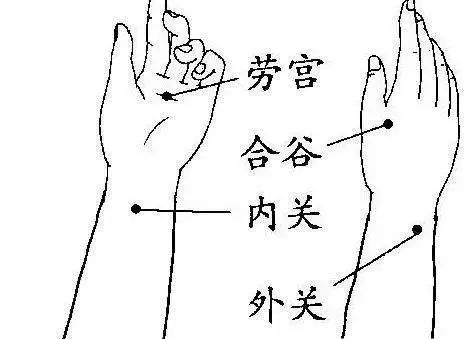
Sancha One Point
Location: Located at the center point of the fork between the index and middle fingers.
Anatomy: Contains the superficial branch of the radial nerve, branches of the lung nerve, and kidney nerve.
Point Selection: Located at the center point of the fork between the index and middle fingers.
Meridian: Enters the Kidney Meridian.
Point Function: Strengthens the spleen, activates collaterals, and promotes blood circulation.
Indications: Keratitis, eye strain, lumbar pain, sciatica, brow pain, visual nerve atrophy, hemiplegia, atrophy.
Needling Method: Insert straight for two inches, entering from the fork to the space between the two metacarpal bones. Insert from the fork while making a fist.
Sensation: Localized aching and distending electric sensation.
Distinction: Although Dong’s Sancha Point is the same as the Eight Evils (八邪) points, the symptoms treated and the needling methods are completely different. The Eight Evils require a three to five tenths needle or three-edged needle for bloodletting, while Dong’s Sancha Point requires a straight two-inch insertion, which is different from the Eight Evils. Readers should carefully distinguish.
Explanation: The Sancha One, Two, and Three points are not listed in Dong Gong’s book but were included by Master Hu in his compilation of Dong’s practical acupuncture points. The Sancha points are key points passed down by Dong Gong, each with different meridian affiliations, possessing the ability to adjust and supplement, and are frequently used by Dong Gong.
Sancha Two Point
Location: Located at the center point of the fork between the middle and ring fingers.
Anatomy: Contains the ulnar nerve hand branch, spleen nerve, and liver branch nerve.
Point Selection: Located at the center point of the fork between the middle and ring fingers.
Meridian: Enters the Spleen and Liver Meridians.
Point Function: Strengthens the spleen, activates collaterals, and promotes blood circulation.
Indications: Pancreatitis, splenomegaly, hemiplegia, sciatica, numbness of hands and feet, liver weakness.
Needling Method: Insert straight for two inches, entering from the fork to the upper edge of the metacarpal bones. Insert from the fork while making a fist.
Sensation: Localized aching and distending electric sensation.
Distinction: Although this point is located the same as the Eight Evils (八邪) points, the symptoms treated and the needling methods are completely different. Please pay attention to the distinction.
Experience:
(1) The Sancha One, Sancha Two, and Sancha Three points, when needled together, greatly assist in recovering physical strength during colds. The Sancha points, like Dong’s extraordinary points such as Shen’er (神耳) and Shuijing (水金水通), have the function of supplementing points, not only treating diseases but also supplementing qi and blood. Individuals with a weak constitution can benefit from needling the Shen’er and Sancha points.
(2) Each Sancha point has its own meridian affiliation, and when used clinically, it is best to combine with palm diagnosis to select appropriate meridian points for better results.
Sancha Three Point
Location: Located at the center point of the fork between the ring and little fingers.
Anatomy: Contains the ulnar nerve hand branch and kidney nerve.
Point Selection: Located at the center point of the fork between the little and ring fingers.
Meridian: Enters the Kidney Meridian.
Point Function: Nourishes the kidney, relieves pain, and promotes diuresis.
Indications: Dizziness, sciatica, bone spurs, lumbar pain, kidney inflammation, kidney disease edema, severe colds.
Needling Method: Insert straight for two inches, entering from the fork to the upper edge of the metacarpal bones. Insert from the fork while making a fist.
Sensation: Localized aching and distending electric sensation.
Distinction: Although this point is located the same as the Eight Evils (八邪) points, the symptoms treated and the needling methods are completely different.
Experience:
(1) The Sancha Three Point enters the Kidney Meridian, thus in the five elements, it belongs to water. Individuals with reduced vision often have kidney water deficiency, as the liver corresponds to wood, which governs the eyes. Therefore, needling the kidney water to supplement the liver wood has a nourishing effect on the eyes, greatly benefiting vision.
(2) After needling the Sancha Three Point, it can also be paired with the Wanshun One Point to form Dong’s T-shaped needling technique, further enhancing the effect.

San重 Point
Location: Located two inches above the San重 Point.
Anatomy: Contains the superficial branches of the lateral sural nerve, branches of the heart nerve, lung nerve, and spleen nerve.
Point Selection: Located two inches above the San重 Point.
Meridian: Enters the Heart, Liver, Spleen, and Lung Meridians.
Point Function: Breaks qi, promotes blood circulation, and eliminates stagnation.
Indications: Same as the San重 Point.
Needling Method: Insert straight for one to two inches. Use a three-edged needle for bloodletting.
Sensation: Localized aching and distending electric sensation.
Explanation: Needling the San重, San重, and San重 points simultaneously forms a straight reverse horse technique, which has the function of promoting qi, breaking blood, and calming the spirit. Especially when paired with needling techniques, it can accelerate the therapeutic effect.
Experience:
(1) The Gynecological Points and San重 points can be paired with the Tianying (天应) needle technique to treat uterine fibroids.
(2) The Shoulder Middle, Jianzhong, and Fen Branch points combined with the San重 point can treat breast tumors.
(3) The San重 point, when paired with the Dizong (地宗) point and Muliu (木留) point, can treat tongue stiffness and speech difficulties, as the San重 point has a strong effect on the brain, improving brain cell function.
(4) For lack of concentration and memory decline, needling the San重 point can be beneficial.
(5) Bloodletting at the San重 point can treat large neck lumps and prostate enlargement (requires pairing with the Zhida (指大间), Waijian (外间), and Sisters Three Points).
10. Lateral Sanli and Lateral Lower Sanli for Trigeminal Neuralgia Have Remarkable Effects, Proven Time and Again

Location: The Lateral Sanli Point is located two and a half inches outward from the Sihua (四花) point, which is one and a half inches outside the Foot Sanli (足三里) point of the fourteen meridians.
Anatomy: Contains the superficial branches of the lateral sural nerve, dental nerve, and branches of the lung nerve.
Point Selection: Located on the anterior edge of the fibula, two and a half inches outward from the Sihua point.
Meridian: Enters the Heart and Lung Meridians.
Point Function: Invigorates blood, dispels stasis, reduces inflammation, and alleviates pain.
Indications: Toothache, facial nerve pain, trigeminal neuralgia, intercostal neuralgia, appendicitis pain.
Needling Method: Insert straight for one to one and a half inches.
Sensation: Localized aching and distending electric sensation.
Experience: This point, along with the External Three Pass (外三关) and San重 points, can be referred to as the lateral lung area of the foot. If there are any discolorations or abnormalities in this area, bloodletting can be performed to treat head and facial conditions, as well as lung and chest-related diseases.
Explanation: This point is effective for treating migraines, thyroid enlargement, and sublingual swelling, similar to the effects of the San重 point. It can be alternated with the San重 point and Sima point for good results.
Pairing Points:
(1) Needling this point can be paired with the Sihua point for bloodletting, which is effective for toothache.
(2) This point can be paired with the Linggu (灵骨) and Heart Gate (心门) points for effective treatment of fullness.
(3) This point can be paired with the San重 point to treat parotitis, and bloodletting can also be performed at the pain point.

